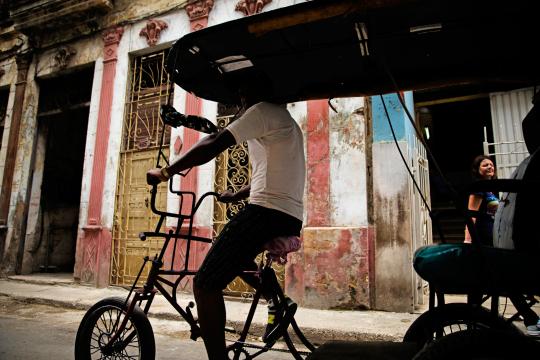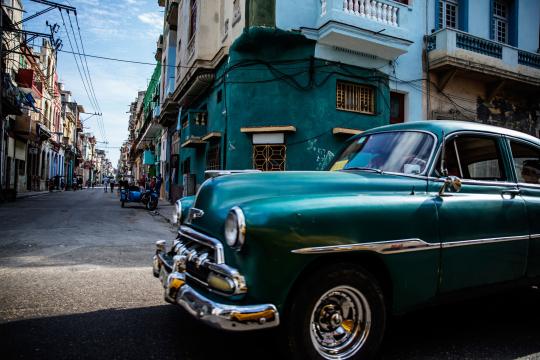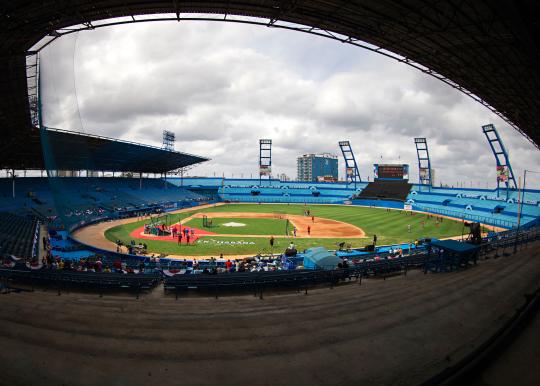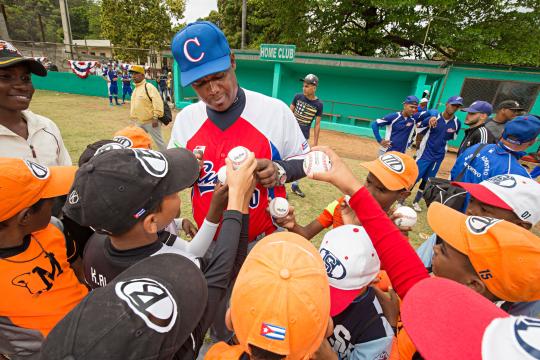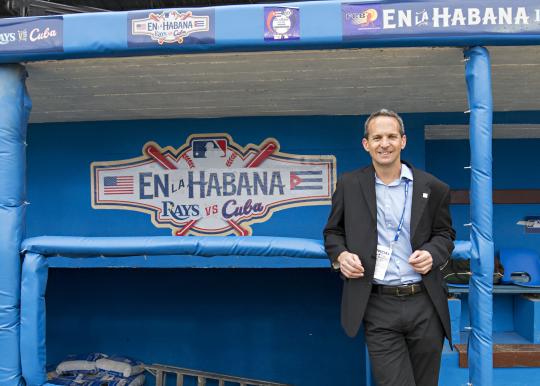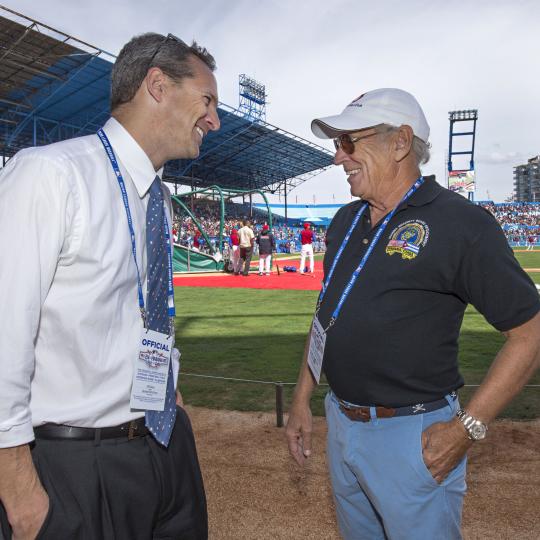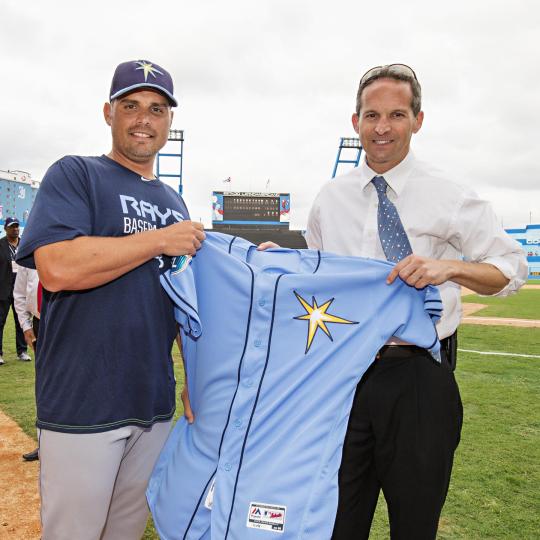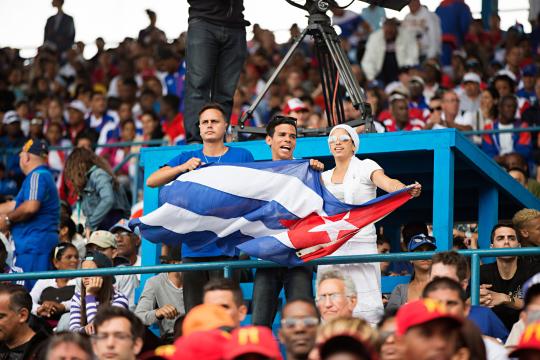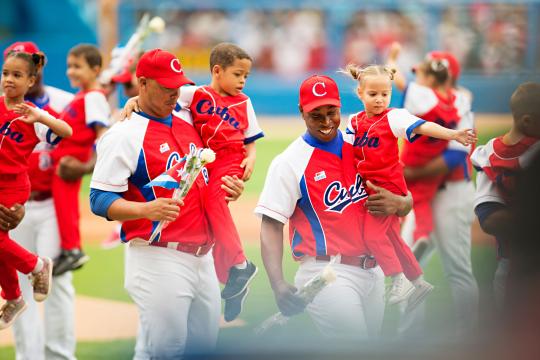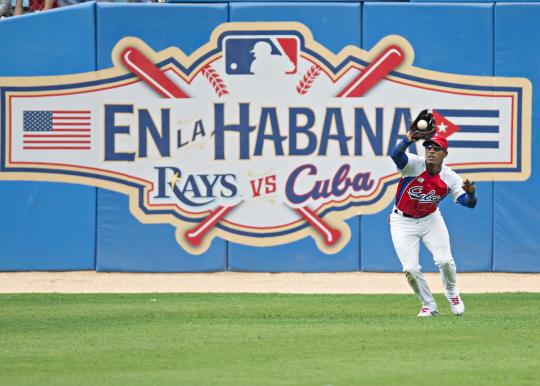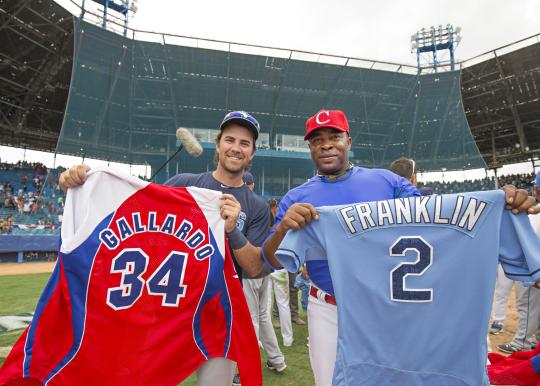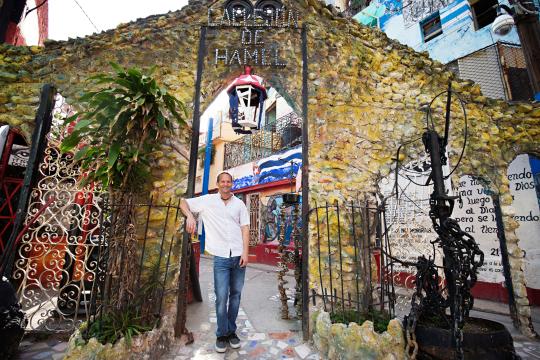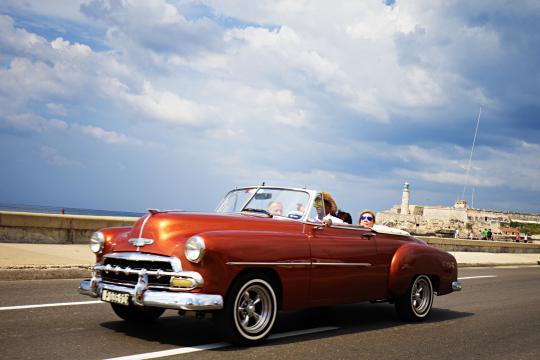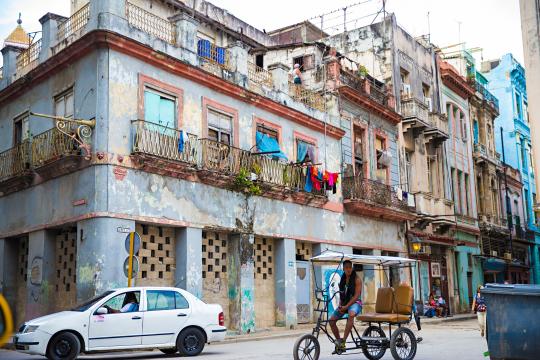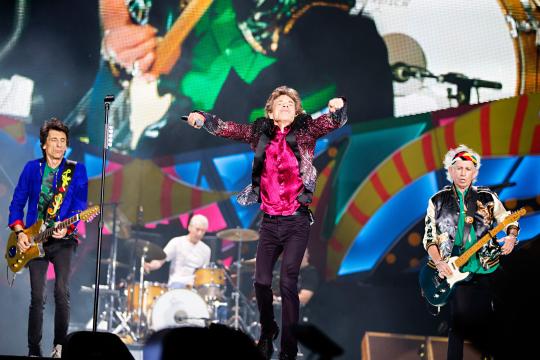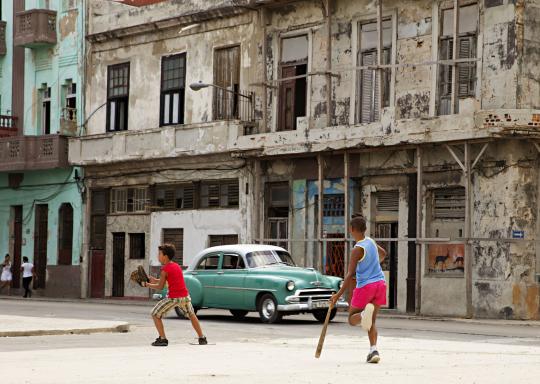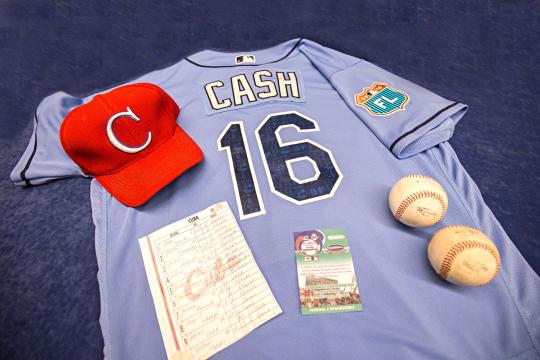- Home
- Our Stories
- A trip back in time
A trip back in time
The two countries are separated by 94 miles of ocean as the crow flies, but Cuba and the United States are worlds apart. Last week, the two nations seemingly moved a step closer toward improving their relationship when Major League Baseball played an exhibition game in Havana for the first time since 1999, and only the second time since the Cuban Revolution more than a half century ago. And as is the case with every important baseball moment, the Hall of Fame was present to document the historic game and other important events that capped an amazing week for Cubans. Jean Fruth, the Museum's traveling photographer, documented the experience poignantly and artistically. I collected artifacts, new relationships were fostered and now the story of baseball's foray into Cuba for the first time in 17 years will live forever in Cooperstown.
Sunday, March 20
Major League Baseball arranged a charter flight from Tampa to Havana for media members and others as part of its traveling party. The flight was delayed by about five hours, leaving at 11:00 p.m., as the airspace was closed in Cuba for President Obama's arrival and heavy rains persisted. I spent some time talking with Luis Tiant, Doug Glanville, Tony Clark, Dave Winfield and Tim Kurkjian. Tiant, whom I admiring as a youngster in Boston in the 1970s, was returning to Cuba for the first time since 2007 and only the second time since departing for good in 1960, when he left for a career in the majors and was not welcome to go home. Glanville, one of the smartest and congenial people I know, was headed over with ESPN and was looking forward to interviewing Rachel Robinson in Cuba. After quietly arriving at José Martí International Airport in Havana, we bussed to the Melia Cohiba hotel, arriving close to 2 a.m. Situated in the center of the city and overlooking the Havana coastline, the European hotel would be baseball headquarters for the next two days.
Monday, March 21
I woke to an overcast, blustery day. Looking out of my 13th floor hotel window, I could see the waves from the Caribbean Sea crashing heavily against the famed Malecón, a wide road and seawall which stretches five miles along the coast of Havana. The wall was constructed in 1901 to protect the city from the seas. Today it still does, and is also popular among fisherman and serves as a boulevard where couples stroll and enjoy the view.
Three successive press conferences started at 8:30 a.m. in one of the Melia ballrooms. The first was with Rays Principal Owner Stu Sternberg, manager Kevin Cash and players Chris Archer and Evan Longoria. The second featured Commissioner Manfred and MLBPA Executive Director Tony Clark, with Cuban Baseball Federation President Higinio Velez and Cuban Baseball Commissioner Heriberto Suarez. The third included Cuban National Team manager Victor Mesa and players Yosvani Torres and Yorbis Borroto. Each group expressed the same sentiment: The excitement for the opportunity to stage a game in Cuba and the hope for a closer relationship between Cuban and American baseball, if the two governments are able to work to make that happen.
From there it was to Estadio Latinoamericano for two more press conferences, and Tampa’s workout. The first featured Joe Torre, Derek Jeter, Tiant, Jose Cardinal and Dave Winfield. The second featured Cuban legendary players Orestes Kindelan, Omar Linares, Pedro Lazo and Antonio Munoz.
The ballpark is home to the Industriales, the most successful team in the post-revolution Cuban baseball league, called the National Series. The Series has 16 teams, one representing each Cuban province, with two from Havana. Each team is made up of players form that province. The season runs from November until February and is 90 games in length, culminating with an eight-team tournament to determine a winner.
Estadio Latinoamericano is the biggest ballpark in Cuba. It opened in 1946 as a 34,000 seat stadium called Estadio del Cerro. After the Revolution, it was renamed Estadio Latinoamericano and now has a capacity of 55,000. Virtually the entire stadium was freshly painted for the game, and nationalistic art adorns some of the corridor walls, along with prominent statues of two great Cuban pitchers: Dolf Luque, who played in the Major Leagues in the early 20th century, and Martín Dihigo.
After the press conferences, Torre, Winfield, Tiant, Jeter and I, along with John Blundell from Major League Baseball, boarded a bus for a lunch at Restaurante Café del Oriente in Old Havana, hosted by Commissioner Manfred for the large contingent of United States officials who traveled to Cuba with the President. I had the chance to briefly meet Congresswoman Pelosi, Congressmen Nolan and Rangel, and Congressman Cohen from Tennessee, who spoke to me at length of his great respect for Minnie Minoso.
It was then off to a clinic at Desa Baseball Field where several Cuban stars, along with current and retired members of the Tampa Bay Rays, provided a clinic for hundreds of young ballplayers. I spent time handing out Hall of Fame pins and plaque postcards of three of the Hall of Famers who hail from Cuba: José de la Caridad Méndez, Martín Dihigo and Tony Pérez. Unfortunately I left the Cristóbal Torriente cards in Cooperstown. The kids and former Cuban stars loved the cards.
Jean, who was shooting the clinic, and I then jumped in a cab back to Estadio Latinoamericano to see the Cuban National team work out. I waited for centerfielder Roel Santos to come off of the field. We had met in Puerto Rico the year before when he kindly donated his jersey to the Museum after Pinar del Rio won the Caribbean Series for Cuba. I told him that when I came to Cuba one day, I would bring him a Hall of Fame jersey. Little did I know it would be just a year later. He was grateful.
One of the press conferences on workout day at the ballpark featured MLBPA Special Assistant//Hall of Famer Dave Winfield, Derek Jeter, MLB Chief Baseball Officer/Hall of Famer Joe Torre, and former major leaguers Luis Tiant and Jose Cardinal, who are both Cuban. The general sentiment shared by the panel is that baseball has historically brought cultures together and serves as a common language among those who adore the game. (Jean Fruth / National Baseball Hall of Fame Library)
Tuesday, March 22
It was game day in Havana and the weather was markedly better, with puffy clouds and temperatures around 80 degrees.
We left the hotel by bus and arrived at the ballpark before 10:00 a.m.
The bleachers were already full, four hours before game time. Both teams worked out and mingled. Musician Jimmy Buffett, who was on the field before the game, told me he wanted to come see the Hall of Fame this summer, as he spends some of his time in upstate New York.
I introduced Roel Santos to Eduardo Perez.
Perez said to me, "hey, he's the kid who had the game- winning hit that knocked us out of the Caribbean Series last year. I know him!" When introducing Santos to Perez, I told Roel about Eduardo's dad Tony’s career, and gave him one of his plaque postcards.
I spoke with Rays’ manager Kevin Cash about donating his jersey, as the players had decided they would give theirs to the Cuban players after the game.
Cash could not have been more accommodating. MLB Authenticator Kevin Noonan and I connected and went to find the umpires in their dressing room.
Four Cuban umpires were joined by Laz Diaz and Angel Hernandez, MLB umpires. Laz assured me that the home plate umpire would take the first pitched baseball out of play for the Hall of Fame.
The Stadium was completely full by noon, two hours before game time. When’s the last time you witnessed that a sporting event?
The Cuban government controlled the tickets, assuring that their country's loyalists were on hand.
The National Team took infield. I don't recall the last time I saw a team take infield.
Ninety minutes before game time, the stadium was quiet, anticipating the arrival of the two Presidents. No music played. Very few Cubans have cell phones.
You could hear a pin drop.
I sat halfway between home plate and third base, with Omar Minaya and Greg Bouris of the Players' Association. Tony Pettiti and Pat Courtney with MLB, and Matt Silverman and others with the Rays, were close by, as were Buffett, Little League Baseball President Steve Keener, and Rosie Rios, the United States Treasurer, whom we worked with on the Hall of Fame coin minted in 2014.
When President Obama and his family arrived, along with President Castro, polite cheers began, with a much louder ovation for Castro. The two world leaders sat near each other.
Both teams made their way toward the seats behind home plate, to shake hands with their country's chief executive. Chris Archer gave President Obama a glove.
The pregame ceremony involved each team’s players introduced individually and walking on to the field with young Cuban children dressed in baseball uniforms.
Hundreds of birds were released as a symbol of peace. And then Tiant and Pedro Lazo – both Cubans – one who starred in America, and one who starred in Cuba, threw out ceremonial first pitches simultaneously.
The game began, and was quite secondary to the enormity of the day’s ceremonies. Tampa beat Cuba, 4-1. James Loney homered and drove in three runs to back Matt Moore’s six shutout innings.
One of the most interesting plays in the game occurred when Rays minor league outfielder, Dayron Varona, who had defected two years earlier, led off the game against his former country.
He popped out on the first pitch, and the ball was taken out of play to go to Cooperstown. After the game he was welcomed warmly by his former teammates.
After the final out I connected with Roel, who tried to help me get a jersey from one of his teammates. The ones we approached wanted to keep them, and understandably so.
Cubans don't generally have much, and a National Team jersey is a precious keepsake, or even a commodity in Cuba. Roel was kind enough to donate his cap to the Museum that he wore in the game. Kevin Cash was delighted that his jersey was going to Cooperstown and Kevin Noonan was able to secure the National Team's lineup card, a great artifact.
Mobile Alabama produced Hall of Famers Billy Williams, Ozzie Smith, Willie McCovey, Satchel Paige and Henry Aaron, not to mention ragtime pianist Jellyroll Morton and singer-songwriter extraordinaire, Jimmy Buffett. Buffett is a regular in Cuba and a baseball fan. (Jean Fruth / National Baseball Hall of Fame Library)
Wednesday, March 23
With the game over and most of the Major League Baseball traveling party departed, my day started with a meeting at the ballpark. Federation President Higinio Velez and members of his staff hosted the meeting. Jean, who has photographed baseball in Cuba a number of times, was also there, given her familiarity with the Federation. So was Lou Schwechheimer and Tommy Goodman with The Caribbean Baseball Initiative (CBI), a U.S.-based foundation whose mission is to use baseball to build a bridge between the U.S. and Cuba. We met in a stadium conference room. We talked about a potential Hall of Fame and Museum at the stadium. We discussed exhibit concepts and program ideas. We toured the prospective site with Omar Linares, a retired Cuban star third baseman with 404 home runs, second most in Cuban baseball history. I secured an Industriales T-shirt for my son and a hat for myself.
The rest of the day was spent touring Havana. The arts community in Havana is prevalent. The streets and buildings are beautifully painted, such as in Callejón de Hamel, an alleyway with colorful wall murals. We paid a visit to popular baseball artist, Reynerio Tamayo. His work is dynamic and colorful. He would be one of three artists I would visit on the trip, along with the very talented Ever Fonseca and Eduardo “Choco” Roca. While at Tamayo’s home, I was interviewed by Cuban baseball historians Yasel Porto and Ismael Sene about the Baseball Hall of Fame for a weekly television program in Cuba.
Callejon de Hamel is a small alley and side street that truly exemplifies Cuban creativity, color and pop art. The surrounding buildings are covered with large murals in vivid colors and where artists sell their wares. The alley is named for Fernando Hamel, a wealthy trader who maintained the entire poor district. It became a cultural hub with music and dancing in the 1990s, the brainchild of Salvador Gonzalez, a visual artist-turned cultural promoter. (Jean Fruth / National Baseball Hall of Fame Library)
Thursday, March 24
Another day and another important meeting, this time with Gladys Collazo, who serves as president of cultural affairs in Cuba, overseeing more than 350 museums and monuments across the island.
She expressed her country's desire to build a sports museum and Hall of Fame to pay tribute to baseball.
We talked about setting a strategy and adhering to best practices. We agreed to keep in touch.
Walking the streets of Old Havana, you can't help but notice the beautiful and ancient architecture from a time almost long forgotten.
The cars are in immaculate condition, even though they are by and large from the 1950s.
They are in beautiful shape, but also a sign of minimal progress. Dominos games are prevalent among the locals.
I even had one of the tastiest glasses of chocolate milk I have ever had, made from famous Cuban chocolate.
Near Parque Central was a small bookstore which houses a treasure trove of baseball books, photos and baseball cards.
There I found some Cuban baseball cards which I purchased for the Museum – some of Cuba's stars who remained in their homeland, and others who defected. From Linares to El Duque.
I was also asked by the shop’s keeper to identify a photo of a baseball coach who was in a photo with Fidel Castro. She gave me a copy for the Museum.
When I returned home, Library research guru Bill Francis helped me to identify the photo of Clyde King, with whom I worked at the Yankees many years later.
In the photo, he was the manager of the Rochester Red Wings and it was taken in Havana in the 1960 season International League season opener against the Havana Sugar Kings.
She gave me a copy for the Museum.
The people I met along the way were polite, friendly and educated, as the universities are all run by the government and accessible to virtually anyone.
Friday, March 25
My final day in Cuba brought the third signature event of the week, along with President Obama's visit and the historic baseball game.
The Rolling Stones became the first major rock and roll band to play a concert in Cuba.
For years, rock and roll was banned in Cuba.
“Years ago it was difficult to hear our music, but here we are," Mick Jagger told the crowd in Spanish. "The times are changing."
There was no admission charge and the concert was held at an old sports complex – Ciudad Deportiva near the airport.
More than 100,000 were in attendance for the 18-song set.
The fans were abuzz with excitement. It was odd attending such a large special event with absolutely no vending. No food, no drinks, no concert T-shirts... Just music.
And what a show Mick and company provided for the masses. You Can't Always Get What You Want (along with Satisfaction) were the two encores, with the predominantly Cuban crowd singing the chorus along with the band.
The Rolling Stones played a free concert in Havana, capping off an historic week in Cuba. Mick Jagger, flanked by Ronnie Wood and Keith Richards, with drummer Charlie Watts in the background, seemed to have a great deal of fun and as The Stones became the first major band to play a concert for the masses in Cuba. (Jean Fruth / National Baseball Hall of Fame Library)
Saturday, March 26
The journey must come to an end. A 4:00 a.m. wakeup call, 4:30 a.m. car to the airport and a 7:30 a.m. flight from Havana to Toronto.
A few more Cuban coffees to keep me awake.
With the artifacts I collected, some art I procured, a few cigars and a little rum, I boarded my flight to Toronto.
It was an easy flight, followed by a five-hour drive to Cooperstown.
Reflecting on the trip, it could not have gone better. We captured the history of the country through artifacts, photography, baseball cards, art, literature and more.
The olive branch of baseball was extended. What will happen next in the relationship between the U.S. and Cuba? Will this trip change things? Time will tell.
Regardless, there’s no doubt that baseball is as much a fabric of the Cuban society, as it is our own.
Jeff Idelson is the President of the National Baseball Hall of Fame and Museum

